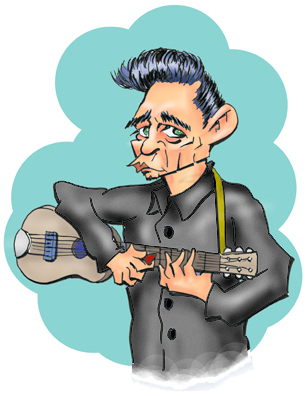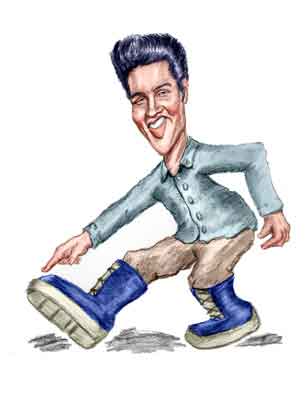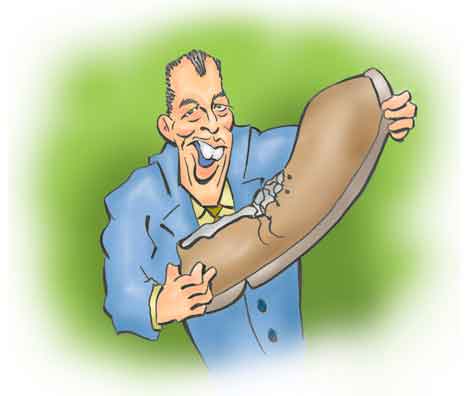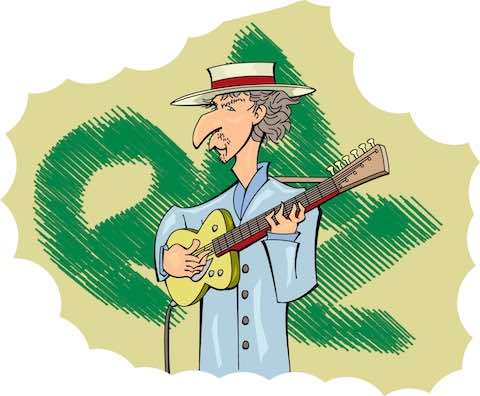Roy Orbison

(Click to Zoom In and Out)
Once during days long past a young man was lamenting how the pop singers were turning to Country and Western. I mean you had Kenny Rogers who left the First Edition and Leon Russell who when he went country covered his tracks with the pseudonym "Hank Wilson". Going back further there was Jerry Lee Lewis ("Whole Lotta Shakin' Goin' On") and Carl Perkins ("Blue Suede Shoes"), both who left the Pop Charts for C&W. Carl went so far as to play guitar for Johnny Cash!
Why, even Roy Orbison went Country after his hit "Pretty Woman"!
Stars of
Sun Records

Johnny Cash ...

... Jerry Lee Lewis ...

... and...
(Hm... Can't think of the name.)
Of course, the cognoscenti know that there has always been a far closer affinity to Country and Popular Music than might seem to be. And never was the line more blurred than the songs issued by Sun Records in Memphis, Tennessee.
And yes, Roy recorded for Sun. In 1956 he and his band - the Teen Kings - recorded "Ooby Dooby" and "Go! Go! Go!" And anyone who hears either side of the shellac knows that these songs - and the others Roy cut for Sun - were not Country and Western.
The whole point, of course, is Sam Phillips - the honorable founder and owner of Sun Records - was more interested in getting his favorite music before the American public than making a buck - although he did the latter as well. One of Sam's favorite genres was Rhythm and Blues which when in the right (or wrong) hands became what was then called Rock 'n' Roll1.
Footnote
"Rock 'n' Roll" actually goes back long before the claim by disc jockey Alan Freed that he invented the term. The earliest uses included any bouncy popular music. Well before the 1950's, even leaders of the swing bands like Benny Goodmen and Gene Krupa were sometimes called "Rock and Roll" men.
What's amazing about Sam is he knew that his company served as a springboard for his artists and once they made it big, the corporations - RCA, MGM, and the like - would woo them away with fat contracts. But that never seemed to bother Sam and if the singers fell on hard times, he would be happy to have them back.
And sure enough, by 1958 Roy was playing on RCA. But the few records he made didn't sell very well and in 1960, Roy had switched to a fledgling producer, Monument Records. There he had what is considered his first hit, "Only the Lonely". Roy was still with Monument in 1964 when he recorded "Oh, Pretty Woman" (often abbreviated in colloquial use to "Pretty Woman"2).
Footnote
For some reason, the record label listed the performers as "Roy Orbison and the Candy Men". Except for his first three platters with Sun, Roy had always been billed solo. Who this mysterious group was and to whence they vanished remains a mystery although we suspect there is an inside joke.
Roy was from Texas and he learned guitar mostly from his dad and uncle. He was a fast learner and had just hit his teens when he began writing songs and playing in his own band. By the time he was fifteen, they were good enough to be playing on the radio station in Kermit, Texas. The show, though, seems to have been mostly for the honor and not much money.
But when the band was actually offered money to play for a dance he was gratified - and amazed - that he made as much in one night as a regular job could pick up in a week. But Roy was prudent and when he graduated high school he enrolled in college.
Of course, Roy kept up his playing, and he and his band - this was the "Teen Kings" - made a record at a small studio in Odessa. He took the platter to a local distributor named Cecil Hollifield. Cecil liked the song and called up his friend, Sam Phillips, in Memphis. He played the record over the phone. Sam told Cecil to have the band come to Memphis and they'd make some records. Roy and the Teen Kings recorded "Ooby Dooby", "Go! Go! Go!", and "Trying to Get to You". But best of all they were signed up for a tour where they opened for bands like Carl Perkins, Johnny Cash, Johnny Horton and Jerry Lee Lewis.
Still Roy's rise to fame took time. From 1956 until 1960, Roy never hit anything really big until "Only the Lonely". That reached #2 on the Billboard charts. The next year he hit #1 with "Running Scared". But he was still not a household name.

Ed Sullivan
The Big Time
Of course, "Oh, Pretty Woman" shot Roy to superstardom. He was on Hollywood a Go Go, Shindig!, American Bandstand, and The Johnny Cash Show. He even hosted his own special and appeared on The Ed Sullivan Show. That was really the big time.
Roy was not just admired by the kids. He had a strong voice and a vocal range that drew praise from his fellow musicians. Elvis claimed that Roy was the best singer he ever heard.
For a while it seemed de rigueur that pop stars had to follow Elvis into motion pictures (even Sonny and Cher made a movie). But Roy's selection was definitely strange. He played the part of a Confederate spy who was going to San Francisco to steal gold bullion from the United States Mint and thus shore up the South's sagging war effort. As an aide to his endeavor he totes a guitar that at the twist of a knob converts into a rifle. The title - and this is no joke - was The Fastest Guitar Alive. Inevitably the movie was a flop.
After the release of "Oh, Pretty Woman", Roy's career began to wane. Ironically this was not necessarily because of the poor reviews of The Fastest Guitar Alive, but was because he had landed a big money contract from MGM. It seems that the powers behind the albums at the big corporations didn't quite have the wherewithal to decide what would sell. So although Roy made a number of albums, some did OK but not great. Roy never had a #1 hit again.
Roy's health was also of concern. Like many people of the time Roy smoked and in 1969, he underwent by-pass surgery. He returned to touring but through the 1970's he had largely fallen from the public scene.

Nobel Laureate
Robert Zimmerman
(One of the Wilburys)
But although superstars dim they never go out. In 1980 Roy recorded a duet with Emmy Lou Harris "That Lovin' You Feelin' Again". Although the record didn't do that great - it only reached #55 on Billboard - it did win a Grammy and brought Roy back to national attention.
Then in 1988 Roy appeared in "Roy Orbison and Friends: A Black and White Night". Roy sang all his favorites and there were also performances by Bonnie Raitt, Bruce Springsteen, Elvis Costello and others. The show was well received.
It was also in 1988 that Roy joined a band where he was just one of equals. Of course these equals included George Harrison and a future winner of the Nobel Prize in Literature named Robert Zimmerman. With a group like that - which they dubbed the Traveling Wilburys - you have to do well and they did.
The Traveling Wilburys released two albums, one in 1988 and the other the following year. Sadly, Roy wasn't around to see the second one. He died December 6, 1988.
References
"Roy Orbison’s Triumphs and Tragedies", Steve Pond, Rolling Stone, January 26, 1989.
"Inside Leon Russell’s Long History With Country Music", Stephen Betts, Rolling Stone, November 13, 2016.
"Roy Orbison", Billboard.
"Roy Orbison", Internet Movie Database.
"Roy Orbison - Discography", Sun Records.
"Roy Orbison", 45Cat.
"The Fastest Guitar Alive", Roy Orbison (actor), Michael D. Moore (director), Sam Katzman (producer), Robert Kent (writer), Internet Movie Data Base, Metro-Goldwyn-Mayer, 1967.